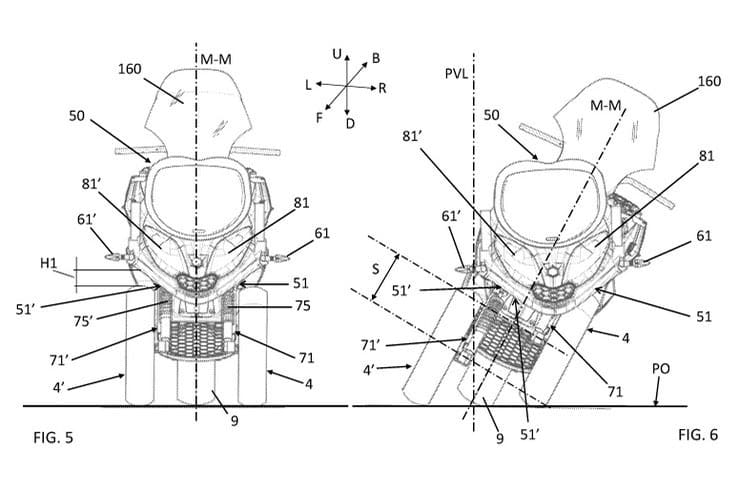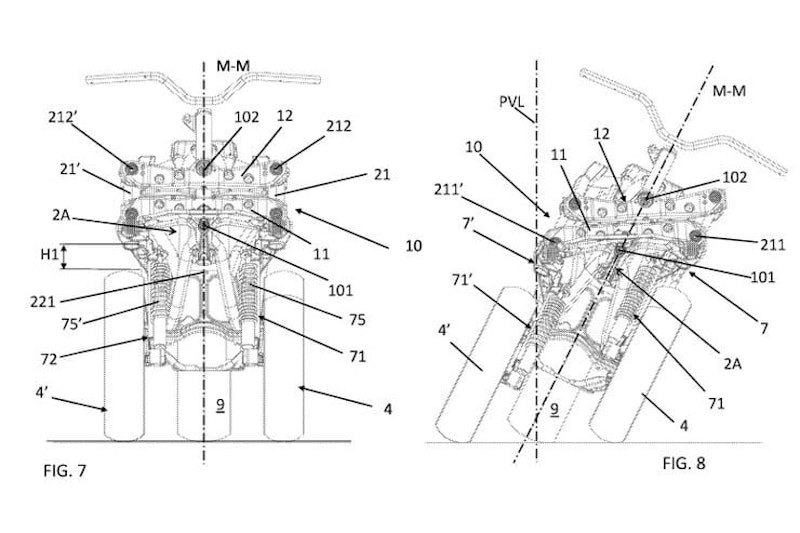Rethink could bring big improvement to Piaggio MP3
By Ben Purvis
Motorcycle Journalist
09.01.2023
A single, surprisingly simple change to Piaggio’s MP3 could reap significant rewards in the bike’s efficiency and aerodynamics according to a new patent application filed by the company.
The document illustrates and describes a new version of the MP3 that takes the same leaning three-wheeled chassis that’s been a familiar part of Piaggio’s range for the last 15 years but changes the nose bodywork so it remains upright while the rest of the bike leans. It’s a design alteration that’s relatively easy to achieve but can improve both the appearance and the aerodynamic performance of the bike, all with minimal additional cost in either components or R&D work.
One of the problems that impacts MP3-style tilting trikes, including rival models like Yamaha’s Tricity and Niken, is that the front bodywork tends to be unusually tall compared to conventional bikes. That’s because the nose has to be high enough to clear not only the suspension movement a front wheel, like a conventional bike, but also to accommodate the fact that during corners, the inside front wheel has to move upwards as the outer one goes down. As well as posing a problem for designers trying to make attractive bodywork, it’s an issue that damages the aerodynamic performance of the bikes. The space between the two front wheels acts like a parachute, trapping air and creating a stumbling block for both performance and economy.
This issue has previously been recognised by the White Motorcycle Concepts WMC300FR, which ducts the air that goes between the wheels through the centre of the bike and out through the back, but Piaggio’s design to mitigate the problem requires less substantial changes.
On the MP3, and most other leaning three-wheelers, the front suspension on each side is held by a parallelogram mechanism above the wheels. This is made up of two horizontal bars that pivot to remain parallel with the road while the rest of the bike leans. Piaggio’s patent application suggests mounting the nose fairing to these bars rather than the main chassis of the bike, so it also remains horizontal.
As a result, the nose no longer has to be mounted high up and can stay low over the front wheels as they lean underneath it. That means much of the air that was previously being trapped between the front wheels can instead be directed up and over the bike, or out to the sides, leaving only enough going under the nose to feed the radiator, like a conventional, two-wheeled bike.
The solution has other benefits, too. The headlights remain parallel to the ground, for instance, so their beam will be much more effective at illuminating your line through a corner without having to resort to adaptive lighting.
Piaggio’s patent suggests that a tall, Perspex screen can still be mounted on the main body of the bike, behind the nose, to protect the rider from wind and rain. It also points out that the nose – now mounted further forward than before – can become a useful luggage space. The patent shows a bonnet-like section that can be lifted to access a storage space above the headlights that’s large enough to take a helmet, or even two of them side-by-side.
While the existence of a patent application is no guaranteed that an idea will progress to production, there’s a lot of sense in this one and it’s an idea that doesn’t appear to involve extensive redesigns of existing components, so perhaps it stands a better chance than most of coming to fruition.
Share on social media:

